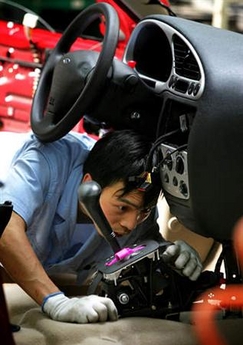Investment-led growth in China's economy remains strong, but an increasing
number of sectors are plagued by overcapacity, said Li Yong, China's vice
finance minister on Saturday in a presentation at the Asian Development Bank's
annual meeting in India.
Iron and steel
Last year, China produced 348 million tons of steel out of its annual
capacity of 470 million tons, says the National Development and Reform
Commission (NDRC).
China will cut annual iron production capacity by 100 million tons and annual
steel production by 55 million tons over the next five years.
Aluminium
In 2005, total production capacity in the country's aluminium industry
reached 10.7 million tons, but national consumption of aluminium only stood at
7.12 million tons, accounting for 75 to 78 per cent of production capacity.
China will continue to apply macro-economic control measures on the aluminium
industry, in order to structurally readjust the entire sector, says the NDRC.

Chinese workers produce cars at the assembly
line at the Changan Ford car factory in Chongqing in this May 27, 2005
file photo. [Reuters] |
Automotive
Annual capacity now stands at 8 million units, already exceeding projected
sales of 5.5 million units in 2005.
Ferroalloy
The State Council urged the further elimination of outdated facilities,
including open carbide furnaces with capacities below 10,000 tons, ferroalloy
ore furnaces below 5,000 KVA, and ferroalloy blast furnaces below 100 cbm.
Coke
Annual national coke output reached 300 million tons, with domestic coke
consumption at a mere 230 million tons.
The NDRC says China will curb overcapacity in the coke production industry,
and encourage consolidation to boost competitiveness.
Calcium carbide
The State Council urged the continued elimination of outdated facilities,
including open carbide furnaces with capacities below 10,000 tons.
Cement
China produced 1.06 billion tons of cement last year, 9.3 per cent more than
in 2004. That growth rate, however, was 3.2 percentage points lower than in
2004.
China will continue to adjust the structure of the cement industry, in order
to ease overcapacity and centralize the industry, says the NDRC.
Coal
The State Council urged the continued elimination of outdated facilities,
including coal-fired mills under 50,000 KW, as well as unsafe coalmines.
Textiles
According to some industry analysts, profit growth in the Chinese textile
industry will slow down to a certain extent, with the overall profit margin
slipping to between 2.5 per cent and 3.1 per cent.
Copper smelting
Total copper smelting production capacity currently stands at 2.05 million
tons, and is expected to reach 3.07 million tons by late 2007. Copper ore from
the domestic market can now only meet about 33 per cent of iron smelting
capacity, and there is still room for further development in the copper smelting
industry.
Electricity
Electrical production capacity reached 500 million kilowatts in 2005, with
overall capacity now standing at 800 million kilowatts. This figure includes 300
million kilowatts of capacity from facilities in development or currently under
construction.
(For more biz stories, please visit Industry Updates)